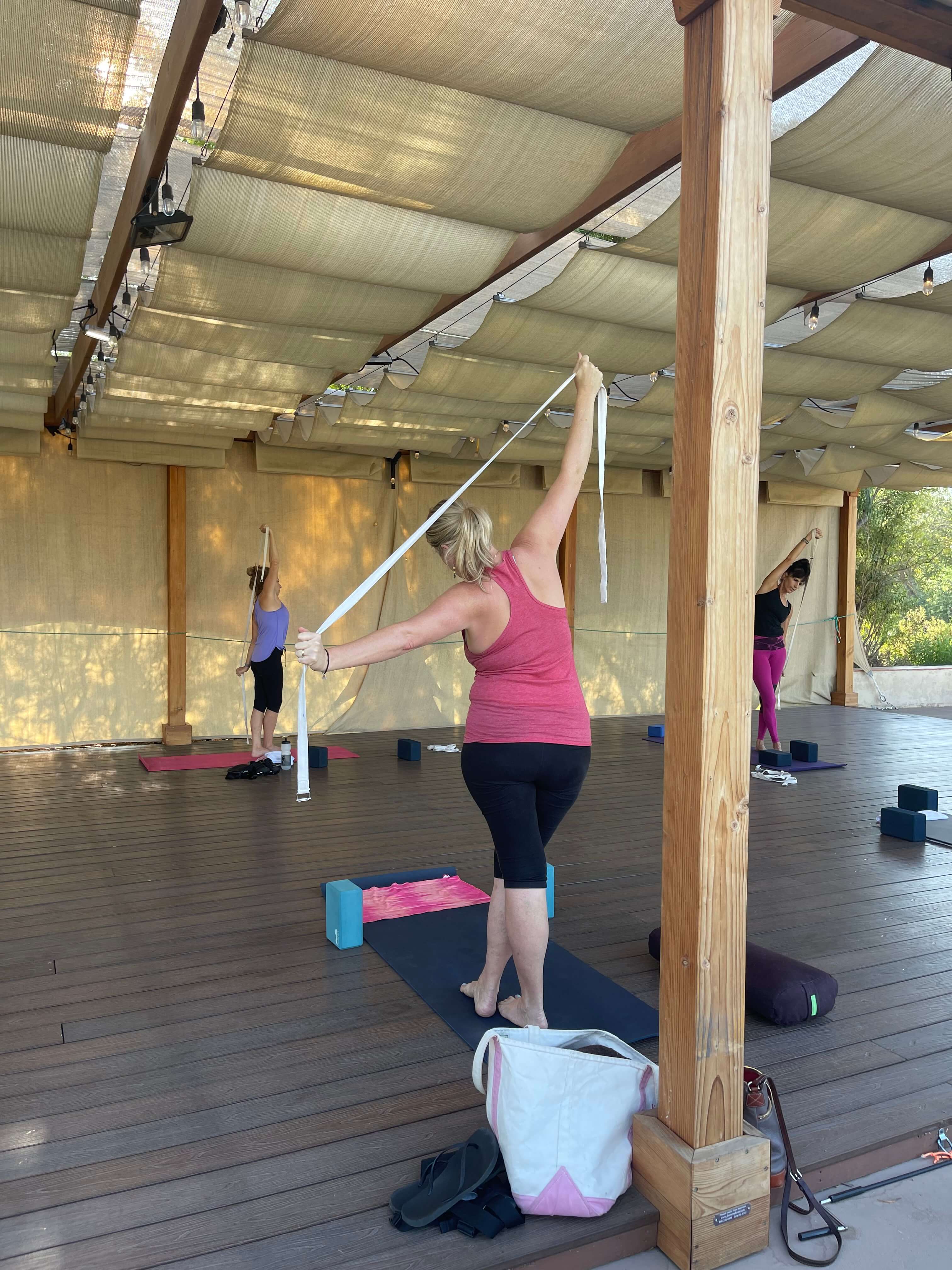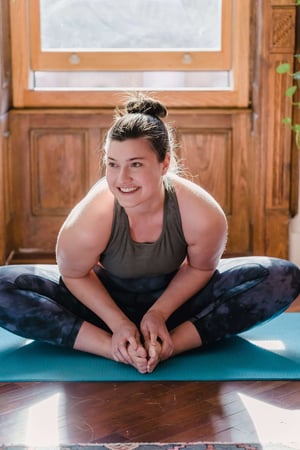How yoga and walking improve outcomes for people with cancer
August 2nd, 2023 | 4 min. read
By Jen Azevedo

We all know that exercise is good for us. Research has proven that physical activity improves cardio health, reduces the chance of diabetes, lowers blood pressure, and improves mental health and overall well-being.
But how does physical activity affect people who are already struggling with disease? Is movement still important? Is it even worth it?
Until recently, the answer to these questions was unknown. But in the last few years, three studies researched this topic and found some interesting answers.
The Paseo Club is a social club in the Santa Clarita Valley. We offer fitness classes, pickleball and tennis courts, and a junior-Olympic pool. We support our members in all stages of life and are always interested in helping everyone achieve the best health possible.
In this article, you will learn how yoga and walking affect the health of people with cancer and why these physical activities improve their outcomes.
 The prevalence of cancer
The prevalence of cancer
As of 2020, over 1,600,000 new cancer cases were reported. More than 600,000 people died of cancer in the same year. One in three people is expected to have cancer at some point in their lifetime.
Cancer is a disease in which some of the body's cells grow uncontrollably and spread. Cancer can attack almost any part of the body — bone, skin, and organs.
Caring for your health when you have cancer
Cancer treatment has grown and developed exponentially since its origins, helping people to live longer, healthier lives.
We know eating healthy and resting are essential steps to take while receiving treatment or recovering from cancer.
But new research shows that resuming movement, even something gradual and low intensity, is an essential part of recovery.
Treating cancer
Chemotherapy and radiation are the most common types of treatment for cancer, although there is also immunotherapy, surgery, laser, and hormonal therapy, depending on the type of cancer and its location.
Cancer-fighting treatments can leave a person exhausted and feeling ill. Common symptoms include:
- Anemia
- Nausea
- Hair loss
- Infection
- Skin changes
- Loss of appetite
- Digestive issues
- Memory problems
- Trouble swallowing
- Easy bruising and bleeding
- Urinary and bladder problems
Cancer also has a huge toll on mental health, causing people to have anxiety and depression. These symptoms are often extremely difficult for most individuals to experience. Because of this, the emphasis on care has been for doctors to encourage rest.
But researchers recently have conducted investigations to see if physical activity could help.
.jpg?width=400&height=300&name=comp_IMG-3654%20(1).jpg) How physical activity affects cancer outcomes
How physical activity affects cancer outcomes
The studies that explored the role of physical activity and cancer outcomes were based on people practicing yoga and walking.
Yoga lowers inflammation
In a randomized trial, researchers studied the effect of yoga on people with cancer and their levels of inflammation. Inflammation is an important marker to watch because it can lead to a high toxicity burden and an increased risk of the spread, recurrence, and development of secondary cancers.
Over 500 cancer patients began a yoga practice or attended health education classes. This class time was for two 75-minute sessions per week for four weeks. The medical center at the University of Rochester found those who took up yoga had “significantly lower levels of pro-inflammatory markers.”
Yoga reduces fatigue and improves the quality of life in cancer patients
The University of Rochester organized a second study that looked at the fatigue levels and overall quality of life of people with cancer.
This study was similar to the prior in that it was a randomized trial with two groups. The first group attended a yoga class, while the second group attended a health education class. Classes were for 75 minutes twice a week for four weeks in total. There were 173 participants.
It was found that people who did yoga had less fatigue, experienced better quality of sleep, and improved quality of life.
Walking extends the lifespan of people with cancer
Dr. Jurema Telles de Oliveira Lima from the Instituto de Medicina Integral in Brazil led a study for over six years, researching the role of activity and cancer patients’ life expectancy.
This study involved 2,600 people. It divided the groups into sedentary and physically active. The physically active group walked 30 minutes per day, five days per week.
After six months, 90% of people in the active group were still alive, compared with 74% of the sedentary group. This study showed that people with cancer who were physically active lived longer lives, and the sedentary group had a higher risk of death.
Dr. Lima stated that she encouraged patients to minimize how much sitting and laying down they do and to get up and move frequently —even doing a few chores around the home or going on a walk helps.
.jpg?width=450&height=300&name=comp_pexels-yan-krukau-8436581%20(1).jpg) Exercise as a part of cancer treatment
Exercise as a part of cancer treatment
The role of exercise in preventing disease and improving physical and mental health has been proven for decades. But new research shows that people receiving treatment for and surviving cancer also benefit from physical activity.
Kathryn Schmitz, Ph.D., M.P.H. of Penn State College of Medicine, stated that based on the new evidence, people with cancer or recovering from cancer should try to follow the general public health recommendations for physical activity which is 2.5 to 5 hours per week of moderate-intensity activity or 1.25 to 2.5 hours per week of vigorous activity.
Exercise regimens must be tailored to each person's interests and abilities. Energy and strength levels vary, so physical activity should be adjusted as needed.
.jpg?width=450&height=349&name=Icomp_MG-3667%20(1).jpg) Final thoughts on yoga and walking affecting cancer outcomes
Final thoughts on yoga and walking affecting cancer outcomes
Physical activity is not what most doctors prescribe to their patients with cancer. But with this new research, the protocol is starting to change.
In this article, you learned yoga and walking can affect how people with cancer feel, sleep, and most importantly, their outcomes. Exercise can reduce the spread and reoccurrence of cancer and lengthen life spans.
With the exciting results of these three studies, more will surely follow, helping there be more information and support for the role of physical activity in being one of many tools to treat cancer.
If you are excited about having a “home away from home,” then the Paseo Club may be the place for you. Join us for over 60 fitness classes each week, from Liquid cardio to yoga, HIIT to Zumba — there is something for everyone.
When members aren’t working out, they enjoy a massage at the onsite spa, a meal at the cafe, or visiting with friends at one of our weekly social events.
Come in for a tour of the Paseo Club and check out our gym spaces, courts, and childcare facilities to see if it is a good fit for you.
Read these three articles to learn more about the health benefits of yoga.
- Yoga
vs. Pilates (and which is best for you)
- Where to get your stretch on — A review of yoga studios in the Santa Clarita Valley
- Benefits of doing yoga as you age (and where to do yoga in the Santa Clarita Valley)
Jen Azevedo is a tennis professional, pickleball professional, personal trainer, group exercise instructor, and the general manager of the Paseo Club. She loves the community at the Paseo Club and that it is also a safe and fun place for her daughter. Jen’s favorite activities are joining her tribe for trail races or her partners for tennis matches. Occasionally Jen slows down to relax with a book — she reads over 100 a year!


.jpg?width=300&height=400&name=comp_IMG_7999%20(2).jpg)
